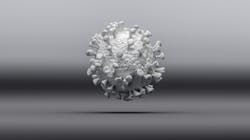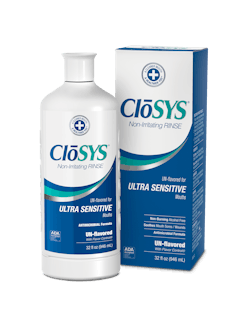Swishing out viruses with new research from Closys Oral Care
Sponsored article
What a year 2020 has been! First, the COVID-19 pandemic reached American shores. Without warning, 95% of dental practices suddenly closed their doors in March and April, followed by the nail-biting reopening of practices during the summer. Hygienists across the country were concerned for their own safety and the safety of their patients as they grasped the emerging threat. They observed the challenges of social distancing within the dental practice, understood the developing need for identifying and quarantining those who fell ill, and yet, through beads of sweat and under layers of personal protective equipment, still continued to provide direct patient care, despite the realities of major loss both in human and economic terms.
While many dental professionals have yet to return to practice, others continue to practice through safety concerns. Dental hygienists have joined health-care workers across the globe, becoming the frontline militia of the COVID-19 battle, working tirelessly to combat widespread health-care disparities and concerns around active infections, mitigating risk factors in susceptible individuals, providing excellent infection control, and discovering the unique sequelae of this virus.
The pandemic continues to unfold, researchers are uncovering the unique attributes and capacities of SARS-CoV-2, which has brought such destruction around the world. Now is a vital time for the dental profession to take stock of what is known, sort through the clutter of scientific claims and guidelines, and chart our course toward a new standard of care—together.
Human coronaviruses
For decades, dental professionals have been practicing in a petri dish of airborne microbes. Within this petri dish are hundreds of coronaviruses. During cold and flu season particularly, people around the world are commonly infected with human coronavirus strains 229E, NL63, OC43, and HKU1, as they are responsible for approximately one-third of common cold cases. While they account for the rise in sales of facial tissues and cold and flu medicine, they rarely lead to a health crisis. In contrast, COVID-19, caused by the novel human coronavirus SARS-CoV-2, has resulted in widespread infection, organ damage, and premature death. It has also illuminated the importance of exacting infection control standards and the need for greater control of airborne pathogens in the dental practice.
While researchers are feverishly working to validate a variety of antiviral medicaments, the journey of utilizing chlorine dioxide for infection control began long before the COVID-19 pandemic.
Chlorine dioxide and viruses
Ten years later, during the SARS-CoV pandemic of 2002, ClO2 gas in an aqueous solution was found to be an efficient agent in inactivating the virus and used to reduce the risk of new outbreaks in the winter of 2003.2 Nearly two decades later, ClO2 has once again provided a solution in the fight against human coronaviruses.
However, only one stabilized ClO2 product has proven efficacy against SARS-CoV-2. Under the direction of award-winning CEO Dr. James Ratcliff, Clorastan, a patented formulation of ClO2 developed by Rowpar Pharmaceuticals, was evaluated against SARS-CoV-2. This no-mix formulation of uniquely stabilized ClO2 in Closys Ultra Sensitive Oral Rinse is currently the only oral rinse whose naturally activated formulation has demonstrated in-vitro virucidal efficacy against SARS-CoV-2. Studies conducted by Microbac Laboratories, Inc. and MRI Global are “going viral,” so to speak, in that they concluded that Closys Ultra Sensitive Rinse reduced viral counts of SARS-CoV-2 by up to 98.4% in 30 seconds.3,4 These results suggest that Clorastan may be a helpful adjunct for the dental professional to consider when aiming to reduce the viral load of SARS-CoV-2 in patients.
Although there is no clear evidence that inactivation of SARS-CoV-2 in the mouth will impact disease transmission, it should be noted that the virus is highly expressed in salivary tissue.5 As such, additional studies are currently under trial through the University of California San Francisco to evaluate whether Clorastan can provide a reduction of viral load in the oral cavity, thus reducing the transmission of COVID-19 across human populations.
This newly emerging research has encouraged dental professionals to integrate the use of a wide array of Closys products in direct patient care for both in-office and for over-the-counter distribution, including their oral rinses, toothpastes, waterline disinfectants, and oral sprays, to name a few.
Conclusion
As society enters the remainder of 2020 with predictions of an emerging “twindemic,” a term for the interdependent events of a cold and flu season amidst the global COVID-19 pandemic, now more than ever, it is imperative for the dental clinician to arm themselves with the weapons necessary to continue the fight against viral threat.
The frontline battlefield has promising new artillery to bring humankind closer to reducing the threat of viral infection from the current global pandemic. More specifically, Closys Ultra Sensitive Rinse may be able to join the fight and that is something for dental professionals to truly “swish around” before suiting up in the fight of the SARS-CoV-2 virus.
For more information, visit closys.com. For patient samples and coupons, click here.
Editor's note: This article is sponsored by Closys Oral Care. Content has been reviewed for editorial integrity. For more information on our editorial standards, see rdhmag.com/page/submission-guidelines.
References
- Ratcliff PA. Method of treating HIV by a topical composition. US patent 6,200,557. March 13, 2001.
- Wang XW, Li JS, Jin M, et al. Study on the resistance of severe acute respiratory syndrome-associated coronavirus. J Virol Methods. 2005;126(1-2):171-7. doi:10.1016/j.jviromet.2005.02.005
- Chiossone C. Virucidal efficacy suspension test – severe acute respiratory syndrome-related coronavirus 2 (SARS-CoV-2) (COVID-19 virus). Microbac Laboratories. July 29, 2020. https://cdn.shopify.com/s/files/1/0239/7795/1296/files/CloSYS_COVID-19_Final_Report_2020_Microbac.pdf?v=1598652810
- Shewale J. Asssessment of mouth rinse against SARS-CoV-2. MRIGlobal. August 26, 2020. https://cdn.shopify.com/s/files/1/0239/7795/1296/files/CloSYS_COVID-19_Final_Report_2020_MRIGlobal.pdf?v=1598652807
- Ceron JJ, Lamy E, Martinez-Subiela S, et al. Use of saliva for diagnosis and monitoring the SARS-CoV-2: a general perspective. J Clin Med. 2020;9(5):1491. doi:10.3390/jcm9051491
KATRINA M. SANDERS, MEd, BSDH, RDH, RF, is a clinical dental hygienist, author, and international speaker. She is the clinical liaison to HygieneExcellence and Innovation for AZPerio. Known as “the dental resultant,” Katrina is cofounder of the Core Group LLC, a boutique-style consulting firm focused on high-level standards, excellence, and production. She is the founder, CEO, and keynote speaker for Sanders Board Preparatory; a published author with Dentaltown and Today’s RDH; a columnist and advisory board member for Modern Hygienist; and brand ambassador for Dimensions of Dental Hygiene.
About the Author

Katrina M. Sanders-Stewart, MEd, BSDH, RDH, RF
A clinical dental hygienist, author and international speaker, Katrina is passionate about elevating the dental profession by creating an undeniable movement that educates, encourages, and empowers the profession to rise in its power. Known as the “Dental WINEgenist™,” she pairs her desire for excellence in the dental industry with her knowledge and passion for wine. She is the Clinical Liaison for Hygiene Excellence at AZPerio, founder of Sanders Board Preparatory and has been published in various publications including RDH Magazine and Dental Academy of Continuing Dental Education. Recently, Katrina proudly received the University of Minnesota Distinguished Alumni Award and the 2024 Sunstar Award of Distinction. @TheDentalWINEgenist [email protected].

